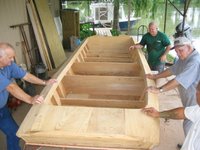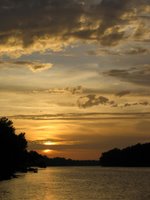Bateau Building VII
Except for small finishing touches and detail, we completed the apprenticeship boat building project today. The primary goal for the final day was to put the bottom on, and we did that. To begin with, we needed to finish what had to be done before the bottom was fitted, do those things you wouldn't be able to reach with the bottom in place, including drilling the remaining drain holes in the bulkheads and the stern board. A few days ago Edward had taken the 16-foot piece of ½ inch marine plywood and placed it so that it would bend at one end, preshaping it to bend to fit the upcurved bow of the boat. He poured hot water on it where he wanted it to bend, and this worked. We took the plywood and placed it on the upside-down boat and put three nails to hold it in place where Edward wanted it. He then marked the plywood with a pencil where it needed to be cut, and then cut it. At this point, the time-critical part of today began. The boat was now ready for the glue that would fix the bottom in a leak-proof seal, and the glue had to be put on all of the places the bottom would touch and the bottom placed and nailed down before the glue dried.
upcurved bow of the boat. He poured hot water on it where he wanted it to bend, and this worked. We took the plywood and placed it on the upside-down boat and put three nails to hold it in place where Edward wanted it. He then marked the plywood with a pencil where it needed to be cut, and then cut it. At this point, the time-critical part of today began. The boat was now ready for the glue that would fix the bottom in a leak-proof seal, and the glue had to be put on all of the places the bottom would touch and the bottom placed and nailed down before the glue dried.  I’m not sure how lo
I’m not sure how lo ng before the glue would be too dry but probably between a half hour and one hour.
ng before the glue would be too dry but probably between a half hour and one hour.
So, three people, Larry, Justin and Edward started smearing glue on the timbers, gunnels, head block and stern board as fast as they could. And then, after placing the bottom on the boat, they did a real production line of drilling and nailing the bottom on, beginning from the stern board and proceeding toward the bow. These three experienced carpenters can put a lot of nails into wood very quickly, even with old-time hammers. Once the rest of the bottom was nailed down, it remained to force the forward end of the bottom down to meet the head block, and that wasn’t easy.  Notice how many clamps that it took to bend the ½ inch plywood. I asked Edward how they did this many years ago in the swamp, without all those clamps, and he said everybody would come over and as many as possible would sit on the boat or pull down on the plywood to make it bend down to fit the bow. Once that was done, a lot of nails (and for us, screws) held it in place. The screws we used are stainless steel and that’s cheating a little, if we were to be doing this totally in the traditional way. But that’s ok; we liv
Notice how many clamps that it took to bend the ½ inch plywood. I asked Edward how they did this many years ago in the swamp, without all those clamps, and he said everybody would come over and as many as possible would sit on the boat or pull down on the plywood to make it bend down to fit the bow. Once that was done, a lot of nails (and for us, screws) held it in place. The screws we used are stainless steel and that’s cheating a little, if we were to be doing this totally in the traditional way. But that’s ok; we liv e in this world now. Anyway, in the Basin they didn’t have electricity to run saws either and without power tools this project would not have been finished on time, which it was.
e in this world now. Anyway, in the Basin they didn’t have electricity to run saws either and without power tools this project would not have been finished on time, which it was.
Last time I mentioned that the tools for each phase of this project changed with the job to be done that day. Today the tools were a h ammer, nails, a drill, saws and clamps – and glue.
ammer, nails, a drill, saws and clamps – and glue.
So, essentially, now the boat is finished. If you put it into the water and put a motor on it, it would do what it was designed to do. It is a beautiful thing, both from a practical  view and from a more esthetic one. The fit of the pieces, the strength of the joints and corners, the graceful curve of the rake of the bow and the overall proportions make this more than just a tool, it is the proud accomplishment of a proud master craftsman and his apprentice sons. Indeed, the state of
view and from a more esthetic one. The fit of the pieces, the strength of the joints and corners, the graceful curve of the rake of the bow and the overall proportions make this more than just a tool, it is the proud accomplishment of a proud master craftsman and his apprentice sons. Indeed, the state of  place there are plans to build another boat, this time with one or more of the apprentices as the lead craftsman. I wish them well.
place there are plans to build another boat, this time with one or more of the apprentices as the lead craftsman. I wish them well.
Throughout this project I have been videoing all of the important steps that led to finishing the work today – from selecting the cypress boards many weeks ago to nailing the bottom on today. There are also about 800 still images of the details of the work all along the way. The intention is to reduce the 14 hours of video to a documentary of one hour or less and make that available to anyone who might have a use for it. The still images would make a good PowerPoint presentation, I believe. It has been my privilege to do these things.
Sunset this evening on the
The river is at 4.3 feet on the Butte La Rose gauge today, falling to 2.4 by Thursday. The
Rise and Shine, Jim




3 Comments:
That's a fine- looking bateau! Thanks for sharing the story, Jim. I have an appreciation for woodwork, bayous and boats, so I have been following the project with much interest.
Glad it provided something to relate to. It was fun doing it. I have gotten comments from other people that tell me stories of their own feeling about boat building. It is good to hear these things.
Jim
Hi, Great blog! I'm blogging the progress of my project in the UK. She's a 17' ply Silhouette MK2.
www.re-buildingthedewdrop.blogspot.com/
Check it out!
Post a Comment
<< Home